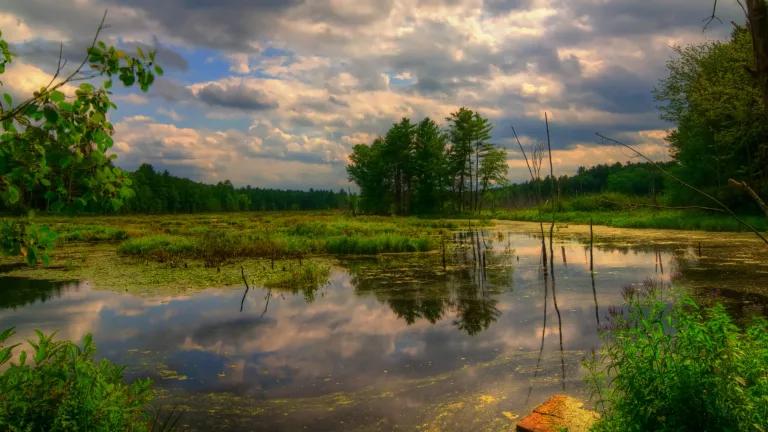The New York legislative session typically ends with many bills being debated and passed in the last few weeks. But the usual journalistic metaphor of a “flurry of bills” seems, for once, too subdued.
From June 3 to June 20, over 550 bills were passed by legislators, five times the number passed from the session’s first day, January 8, through June 2. That’s more like a blizzard (which Albany experienced as a literal event at least once this session, as well).
The first “flurry” of activity, legislatively speaking, is usually the passage of the New York State budget, ideally before April 1, which is the formal deadline. However in the bad, old days, this was regularly ignored. These days the legislature would risk a brutal excoriation from the New York tabloids (which lose a fortune annually but who’s counting). This would mean major political fall-out, particular in an election year, which 2014 most assuredly is.
The budget session went reasonably well for environmentalists – the Environmental Protection Fund (EPF), a source of funding for multiple programs we care about from land preservation to ocean conservation and zoos, was increased by $10 million, a move in the right direction. The EPF was eviscerated by Governor David Paterson, in a panic over the Panic of 2008 and has very slowly been gaining ground in the Cuomo era. Importantly, the EPF line funding ocean protections was also raised specifically. Some of that new money will renew an important whale monitoring program defunded in the Paterson term.
During the budget process, there was an attempt by the New York State Automobile Dealers to shut out Tesla, the electric vehicle manufacturer, in New York. The PAC-powerful auto dealers wanted to prohibit Tesla’s direct sales operations, since that business model was perceived as an assault on the dealership structure which has dominated auto sales in the US post -World War II. NRDC worked within a highly charged, adversarial process to allow Tesla to maintain its five retailer-owned outlets. An agreement was struck which kept Tesla in New York -- the dealers have squeezed the EV company out of New Jersey, Texas and Arizona with action in other states on the horizon.
Also earlier in the session, the Governor, the Public Service Commission (PSC) and the New York State Energy Research and Development Authority (NYSERDA) finalized through the rate-making process, a plan called NY-Sun, which commits a $1 billion investment over the next 10 years in solar photovoltaics. This translates roughly into 3,000 MWs of power, 13,000 jobs and the removal of 2.3 million tons of greenhouse gas emissions.
The NRDC energy team worked closely with the Governor’s office and state agencies in the development of this landmark plan, as well as building a broad base of support among labor, business and civic organizations against the strenuous opposition of some of New York’s private power companies. NY-Sun immediately catapults New York State into the front ranks of solar financing and development in the country. This level of investment has elsewhere attracted a substantial base of solar manufacturers to the location where the investments are being made. This indicates that an investment in renewables has a payoff not just in environmental benefits, but as an engine of economic development.
In the waning hours of the session, many bills are trapped in the bureaucratic maw of the legislative labyrinth. The Sweeney-Avella (Bob Sweeney, the retiring Chairman of the Assembly Environmental Conservation Committee; Tony Avella, the vice-chair of the Senate Environment Committee) three-year fracking moratorium was one we worked on this year that got waylaid.
There are numerous reasons why caution right now regarding fracking makes sense – study after study in the past year or so suggests that health concerns associated with this industrial process are profoundly relevant. There have been many instances of well casing and cement failures in the process that can contaminate groundwater; and hazardous air pollutants from venting and flaring operations on the fracking sites can impact air quality. Most remarkably, the industry has yet to solve the central problem of how to dispose of the fracked wastewater in a safe way. Several agencies and institutions are undertaking comprehensive studies of the health effects of fracking and already are uncovering critical data. The bill passed the Assembly but never made it to the Senate floor. A resolute team of medical doctors and health professionals accompanied the environmental team lobbying in favor of the bill and contributed greatly in educating elected officials and legislative staff.
Two bills fared better in the final 24 hours. The ungainly named Community Risk Reduction and Resiliency Act, another Sweeney bill, traveled a difficult path in the Assembly. Its companion, sponsored by Senator Diane Savino, met similar turbulence in the Senate, though both eventually passed. Spawned in the wake of the powerful (and historic) storms Irene, Lee and Sandy, the bill argued that the conservation of vital natural resources like marshes, floodplains and dunes can moderate the impact of extreme weather. The legislation compels state and community planners as well as developers to consider the impacts of sea level rise, storm surges and flooding in future permitting programs. The bill, if signed into law by the Governor, will add an important layer of analysis into the overall response of the public sector after a catastrophic storm, rather than just the simple impulse to rebuild on the same vulnerable location.
Yet another Sweeney bill became a central focus of both houses in the last two days of session. His bill to ban the sale of illegal ivory had broad support among legislative members and the public (82% of New Yorkers supported the ban according to polling) but met resistance from the auction houses.
New York is the number one importer of elephant ivory in the United States, second only to China in the world. The bill, sponsored by Republican Senator Andrew Lanza in the upper house, placed a permanent ban on the sale of elephant and mammoth ivory and rhino horn. The bill also issues permits for the sale of 100 year-old antique ivory items with less than 20% volume of elephant ivory, but only if there is extensively documented provenance. There are exemptions for scientific and educational use. In addition, the bill imposes much stronger financial penalties than existing laws and increases the criminal sanctions to a Class D felony for attempted sale of illegal ivory worth more than $25,000, a penalty that vastly increases the likelihood of jail time for offenders.
Governor Cuomo strongly supported the ivory bill and will sign it into law over the summer. During the last week, the battle for the bill’s passage took an unlikely, surreal turn when lobbyists for the National Rifle Association (NRA) appeared in the Senate chambers opposing the bill. Some upstate Republican members folded under the riflemen’s pressure, but the bill passed the Senate comfortably 43-17, giving New York the strongest ivory ban law in the country.
Overall, we fared well through the blizzard of bills this past session. And we’ll continue our hard work in Albany to prepare for the next storm.




